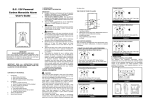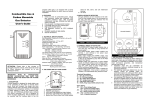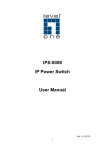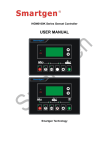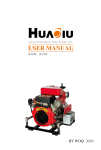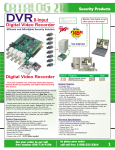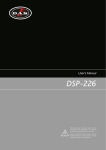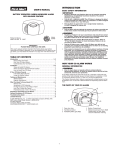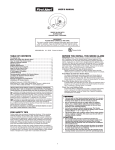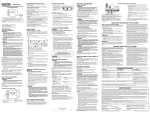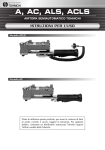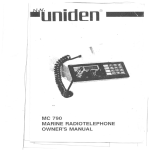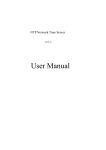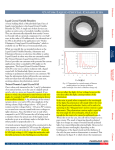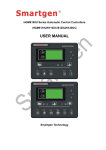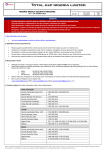Download User`s Manual - convoytech.com
Transcript
Alarm /Fault IMPORTANT! PLEASE READ CAREFULLY AND SAVE. This user’s manual contains important information about your Carbon Monoxide (CO) Alarm’s operation. If you are installing this CO Alarm for use by others, you must leave this manual—or a copy of it—with the end user. IMPORTANT! READ ALL INSTRUCTIONS BEFORE INSTALLATION AND KEEP THIS MANUAL NEAR THE ALARM FOR FUTURE REFERENCE. ! CAUTION! Leave your CO Alarm plugged in year-round. CO problems can occur any time during the year, and this Alarm can only alert you if it is plugged in and receiving power. This CO Alarm is intended for use in a standard DC9V~28V, or AC90V~270V power supply. It is not intended for use in extension cords, power strips, or outlets controlled by a switch or dimmer. These may not provide continuous power to the unit. When fully powered, it samples the air and takes a new reading about every second. A microchip inside the unit stores each reading, and remembers the levels of CO it has been exposed to over time. The unit goes into alarm mode when it has been exposed to a “critical” level of CO (measured in parts per million or “ppm”) within a specified time (measured in minutes). This Carbon Monoxide Alarm features a permanently installed sensor, three colored indicator lights, and an 85dB alarm horn. It also has a Silence Feature to temporarily quiet the alarm horn. During Normal Operating status Using the Silence Feature in Alarm Green light ON & Yellow OFF. Horn silent. Red lights flashes once every 6 seconds when sampling the air. Green light ON, Yellow light OFF, Red light FLASHES. Horn OFF. Relay output (The silence status keep 4 minute and then the unit exit to normal status.) Press Test again to exit the silence status. FIGURE 2 FIGURE 7 During Normal Test When the unit in the Normal status, press Test button to enter Test Status, All three lights ON. Horn ON The wireless module will transmit wireless signals. FIGURE 3 During an Alarm ! l l l l l l ! CAUTION! This CO Alarm will only indicate the presence of carbon monoxide gas at the sensor. Carbon monoxide gas may be present in other areas. ! ! WARNING! The Silence Feature is for your convenience only and will not correct a CO problem. Always check your home for a potential problem after any alarm. Failure to do so can result in injury or death. This CO Alarm cannot operate without continuous electricity. It does not operate during a power failure. NEVER ignore your Carbon Monoxide Alarm if it alarms. Refer to “If Your CO Alarm Sounds” for more information. Failure to do so can result in injury or death. Test the CO Alarm once a week. If the CO Alarm ever fails to test correctly, have it replaced immediately! If the CO Alarm is not working properly, it cannot alert you to a problem. This product is intended for use in ordinary indoor locations of family living units. It is not designed to measure CO levels in compliance with Occupational Safety and Health Administration (OSHA) commercial or industrial standards. Individuals with medical conditions that may make them more sensitive to carbon monoxide BEDROOM BEDROOM 4. THE COVER OF YOUR CO ALARM LIVING ROOM HALL KITCHEN BEDROOM GARAGE BASEMENT 1. INTRODUCTION 1.1 BASIC SAFETY INFORMATION IMPORTANT! l Dangers, Warnings, and Cautions alert you to important operating instructions or to potentially hazardous situations. Pay special attention to these items. l THIS IS NOT A SMOKE ALARM! This CO Alarm is designed to detect carbon monoxide from ANY source of combustion. It is NOT designed to detect smoke, fire, or any other gas. l This CO Alarm is approved for use in single-family residences. It is NOT designed for marine use. 2. INSTALLATION 2.1 WHERE TO INSTALL CO ALARMS The National Fire Protection Association (NFPA) recommends that a CO Alarm should be centrally located outside of each separate sleeping area in the immediate vicinity of the bedrooms. For added protection, install additional CO Alarms in each separate bedroom, and on every level of your home. REQUIRED TO MEET NFPA RECOMMENDAT IONS 1 2 Test 4 Power Alarm /Fault 3 5 SUGGESTED AREAS FOR INSTALLING ADDITIONAL CO ALARMS Green light ON, Yellow light OFF, Red light On. Horn ON. Horn chirp twice per one second. The wireless module will output wireless alarm signals, or the relay output module relay contacts, or the electric valve module output pulse voltage signals, or the electric hand module output continuous voltage signals. FIGURE 4 1. Test/Silence/Reset Button 2. POWER Light (Green) 3. ALARM Light (Red)/FAULT(SERVICE) Light (Yellow) 4. (Behind the Cover) Alarm Horn: 85dB audible alarm for test, alarm, and unit malfunction warning. 5. Air Vents MALFUNCTION WARNING This unit performs self-diagnostic tests approximately every second. If the Alarm malfunctions, it should be replaced immediately. FIGURE 8 32 m m Test Power Alarm /Fault 67 mm Test Power may consider using warning devices which provide audible and visual signals for carbon monoxide concentrations under 30 ppm. For additional information on carbon monoxide and your medical condition contact your physician. 1.2 HOW YOUR CO ALARM WORKS GENERAL INFORMATION 115mm Carbon Monoxide Alarm User’s Guide During an Fault(Alarm Malfunction) Bra cket 7 2m m FIGURE 9 UNIT & INSTALLATION BRACKET Green light ON. Red light OFF. Yellow light ON. Horn chirp once per two seconds FIGURE 5 1.3 WHAT THE LIGHTS AND ALARM TONES MEAN During Power Up (Sensor Warm Up time) Green light ON & red lights OFF. Yellow Flashes Horn “chirps” once when power up, and “chirp” twice at the end of Warm Up time. During warm up time (1 to 3 minute), the unit don’t response to any operation. FIGURE 1 Using the Reset in Alarm In Alarm status, Press and hold TEST button up 4 seconds,the unit restore to Normal status. FIGURE 6 FIGURE 10 TERMINAL WIRING Terminal is on the back of the detector. from left to right is terminal 1 to terminal 6. See Figure 10. Terminal wiring is different according to the module, please see Figure 11,12,13,14 NOTE: 1. The AC90~AC270 power supply module has a wire with plug. Not need to using terminal for power supply. 2. The DC9V~DC28V power supply module use terminal 5 and terminal 6 as power input (Unpolarized wire input). 3. Relay output module has NO/NC output. See Figure 11. 4. Electric Fan drive module relay output is capable for load of 1A@220AC, if the current is exceed the limitation, one intermediate relay should be used. See Figure 13. 5. Electric Valve module alarm output is pulse voltage output. Electric hand drive module alarm output is continuous voltage output. It’s forbidden to provide continuous voltage output to electric valve, if not the detector may be damaged. separate sleeping area. For added protection, install an additional CO Alarm at least 20 feet (6 meters) away from the furnace or fuel burning heat source. a Multi-level Home: Install at least one CO Alarm near or within each separate sleeping area. For added protection, install at least one CO Alarm on each level of the home. If you have a basement, install that CO Alarm at the top of the basement stairs. For added protection, install an additional CO Alarm at least 20 feet (6 meters) away from the furnace or fuel burning heat source. l In l l l ! ! NO FIGURE 11 + FIGURE 12 NC COM DC9V~28V INPUT RELAY OUTPUT MODULE - ELECTRIC HAND DRIVE MODULE WARNING! This unit does not work without power. Choose an outlet where it can’t be accidentally unplugged or switched off by children. Keep small children away from the unit. Teach them not to play with it or unplug it. Explain what the alarms mean. 2.2 WHERE CO ALARMS SHOULD NOT BE INSTALLED DO NOT LOCATE THIS CO ALARM: l In garages, kitchens, furnace rooms, or in any extremely dusty, dirty or greasy areas. l Closer than 20 feet from a furnace or other fuel burning heat source, or fuel burning appliances like a water heater. l Within 5 feet of any cooking appliance. l In extremely humid areas. This alarm should be at least 10 feet from a bath or shower, sauna, humidifier, vaporizer, dishwasher, laundry room, utility room or other source of high humidity. l In areas where temperature is colder than 40°F (4°C) or hotter than 100°F (38°C). These areas include unconditioned crawl spaces, unfinished attics, uninsulated or poorly insulated ceilings, porches, and garages. l In turbulent air, like near ceiling fans, heat vents, air conditioners, fresh air returns, or open windows. Blowing air may prevent CO from reaching the sensors. l In direct sunlight. l In outlets covered by curtains or other obstruction. ! ! AC220V/1A FIGURE 13 L N ELECTRIC FAN DRIVE MODULE ! ! + FIGURE 14 - ELECTRIC VALVE DRIVE MODULE If your bedroom hallway is longer than 40 feet, install a CO Alarm at BOTH ends of the hallway. In a Single-level Home: l Install at least one CO Alarm near or within each ! ! WARNING! This CO Alarm is designed for use inside a single-family home or apartment. It is not meant to be used in common lobbies, hallways, or basements of multi-family buildings unless working CO Alarms are also installed in each family living unit. CO Alarms in common areas may not be heard from inside individual family living units. WARNING! This CO Alarm alone is not a suitable substitute for complete detection systems in places which house many people, like hotels or dormitories, unless a CO Alarm is also placed in each unit. WARNING! DO NOT use this CO Alarm in warehouses, industrial or commercial buildings, special-purpose non-residential buildings, RVs, boats, or airplanes. This CO Alarm is specifically designed for residential use, and may not provide adequate protection in non-residential applications. 2.3 HOW TO INSTALL YOUR CO ALARM This CO Alarm cannot operate without continuous electricity. It does not operate during a power failure. Do not use in an extension cord, or outlet controlled by a dimmer or switch—unit must have a constant power supply. Leave your CO Alarm plugged in year-round. CO problems can occur any time during the year, and this alarm can only alert you if it is plugged in and receiving power. 1. Connect DC12V to the unit. In horizontally or vertically positioned wall outlets, mount unit with Test button facing upward. 2. Make sure green light shines when you plug in the unit. It will shine continuously when unit is receiving power. The horn will “chirp” once during power up, or when power is restored after an outage. 3. Test by pressing the Test button firmly until the unit sounds. The sound would sound. During testing, the green, yellow, and red lights ON or flash. This is normal. 4. While testing the unit, have a family member check that the horn can be easily heard from the sleeping areas. The unit should be located where it can wake you if it alarms at night. 5. Find the pair of self-adhesive labels included with this CO Alarm. l On each label write in the phone number of your emergency responder (like 911) and a qualified appliance technician. l Place one label near the CO Alarm, and the other label in the “fresh air” location you plan to go if the alarm sounds. NOTE: A qualified appliance technician is defined as “a person, firm, corporation, or company that either in person or through a representative, is engaged in and responsible for the installation, testing, servicing, or replacement of heating, ventilation, air conditioning (HVAC) equipment, combustion appliances and equipment, and/or gas fireplaces or other decorative combustion equipment.” 3. IF YOUR CO ALARM SOUNDS Actuation of your CO alarm indicates the presence of carbon monoxide (CO) which can kill you. In other words, when your CO Alarm sounds, you must not ignore it! 3.1 IF THE ALARM SIGNAL SOUNDS: 1. Operate the Test/Silence button. 2. Call your emergency services, fire department or 911. Write down the number of your local emergency service here: ________________________________________ 3. Immediately move to fresh air—outdoors or by an open door or window. Do a head count to check that all persons are accounted for. Do not reenter the premises, or move away from the open door or window until the emergency services responder has arrived, the premises have been aired out, and your CO Alarm remains in its normal condition. 4. After following steps 1-3, if your CO Alarm reactivates within a 24-hour period, repeat steps 1-3 and call a qualified appliance technician to investigate for sources of CO from fuel-burning equipment and appliances, and inspect for proper operation of this equipment. If problems are identified during this inspection have the equipment serviced immediately. Note any combustion equipment not inspected by the technician, and consult the manufacturers’ instructions, or contact the manufacturers directly, for more information about CO safety and this equipment. Make sure that motor vehicles are not, and have not, been operating in an attached garage or adjacent to the residence. Write down the number of a qualified appliance technician here: ______________________________ “ALARM-MOVE TO FRESH AIR” If you hear the alarm horn and the red light is on, move everyone to a source of fresh air. DO NOT unplug the CO Alarm! 3.2 FINDING THE SOURCE OF CO AFTER AN ALARM Because CO may dissipate by the time an investigator arrives, it may be difficult to locate the source of CO. See “What You Need to Know About CO.” Convoy Security Technology shall not be obligated to pay for any carbon monoxide investigation or service call. 3.3 USING THE SILENCE FEATURE The Silence Feature is intended to temporarily silence your CO Alarm’s alarm horn while you correct the problem—it will not correct a CO problem. While the alarm is silenced, it will continue to monitor the air for CO. When CO reaches alarm levels, the alarm will sound. Press and hold the Test/Silence button until the horn is silent. The initial Silence cycle will last approximately 4 minutes. 4. TESTING AND MAINTENANCE 4.1 WEEKLY TESTING ! WARNING! ! Test the CO Alarm once a week. If the CO Alarm ever fails to test correctly, have it replaced immediately! If the CO Alarm is not working properly, it cannot alert you to a problem. Push and hold the Test button on the cover until a loud alarm sounds. The alarm sequence should last for 5-6 seconds. If the CO Alarm ever fails to test properly, replace it immediately. If the CO Alarm is not working properly, refer to the “Limited Warranty” at the end of this manual. ! ! WARNING! The Test button is the only proper way to test the CO Alarm. NEVER use vehicle exhaust! Exhaust may cause permanent damage and voids your warranty. ! ! WARNING! DO NOT stand close to the CO Alarm when the horn is sounding. Exposure at close range may be harmful to your hearing. When testing, step away when horn starts sounding. 4.2 REGULAR MAINTENANCE To keep the CO Alarm in good working order: l Test it every week using the Test button. l Vacuum the CO Alarm cover at least twice a year, using the soft brush attachment. Test the CO Alarm again after vacuuming. ! ! CAUTION! DO NOT spray cleaning chemicals or insect sprays directly on or near the CO Alarm. DO NOT paint over the CO Alarm. Doing so may cause permanent damage. IMPORTANT! Household cleaners, aerosol chemicals and other contaminants can affect the sensor. When using any of these materials near the CO Alarm, make sure the room is well ventilated. IMPORTANT! If your home is being fumigated, unplug the unit temporarily and put it where it will not be exposed to chemicals or fumes. When fumigation is complete and all traces of fumes clear, plug the unit back in and retest it.


